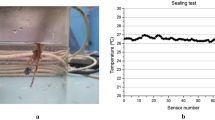Abstract
The long-term performance of concrete subjected to freezing and thawing damage is experimentally studied. The ASTM procedures for rapid freezing and thawing are followed to condition all the test samples. Dynamic modulus of elasticity and fracture energy for different numbers of freeze/thaw (F/T) cycles are measured through nondestructive modal and cohesive fracture tests, respectively. Nonlinear regression analysis is adopted to analyze the test data, and the relationship between the relative dynamic modulus and the number of F/T cycles is established. Based on the three-parameter Weibull distribution model, the probabilistic damage analysis is performed, from which the relationships between the number of F/T cycles and damage parameter for different probabilities of reliability are established. Based on the correlations between the available field environment and the indoor laboratory experiment, the field service-life of the considered structural concrete is predicted and validated with the fracture energy test data.










Similar content being viewed by others
References
Powers T (1945) A working hypothesis for further studies of frost resistance of concrete. J Am Concr Inst 16:172–245
Powers T, Helmuth R (1953) Theory of volume changes in hardened Portland cement paste during freezing Highway. Highw Res Board Proc 32:285–297
Powers T (1955) Basic considerations pertaining to freezing and thawing tests. Am Soc Test Mater Proc 55:1132–1155
Cho T (2007) Prediction of cyclic freeze–thaw damage in concrete structures based on response surface method. Constr Build Mater 21:2031–2040
Jacobsen S, Sellevold EJ, Matala S (1996) Frost durability of high strength concrete: effect of internal cracking on ice formation. Cem Concr Res 26:919–931
Mazars J (1987) Comportement et endommagement du béton sous charges monotones et cycliques. “ Journées E.D.F., “Calcul dynamique des barrages, Aixles-Bains
Bogdanoff JL, Kozin F (1980) A new cumulative damage model. J Appl Mech 47(1):40–44
Breysse D (1990) Probabilistic formulation of damage-evolution law of cementitious composites. J Eng Mech 116(7):1489–1510
Shen H, Lin J, Mu E (2000) Probabilistic model on stochastic fatigue damage. Int J Fatigue 22(7):569–572
Li H, Zhang M, Ou J (2007) Flexural fatigue performance of concrete containing nano-particles for pavement. Int J Fatigue 29:1292–1301
Sain T, Chandra Kishen J (2008) Probabilistic assessment of fatigue crack growth in concrete. Int J Fatigue 30:2156–2164
Rutherford J, Langan B, Ward M (1994) Use of control specimens in freezing and thawing testing of concrete. Cem Concr Aggreg 16:78–82
ASTM C231/C231 M—10 (2010) Standard test method for air content of freshly mixed concrete by the pressure method. In: American society for testing and materials, vol 04.02. ASTM, Philadelphia
ASTM C143/C143 M—10a (2010) Standard test method for slump of hydraulic cement concrete. In: American society for testing and materials, vol 04.02. ASTM, Philadelphia
ASTM C39/C39 M—10 (2010) Standard test method for compressive strength of cylindrical concrete specimens. In: American society for testing and materials, vol 04.02. ASTM, Philadelphia
ASTM C78/C78 M—10 (2010) Standard test method for flexural strength of concrete (using simple beam with third-point loading). In: American society for testing and materials, vol 04.02. ASTM, Philadelphia
ASTM C496/C496 M—11 (2010) Standard test method for splitting tensile strength of cylindrical concrete specimens. In: American society for testing and materials, vol 04.02. ASTM, Philadelphia
ASTM C666 (1992) Standard test method for resistance of concrete to rapid freezing and thawing. In: Annual book of ASTM standards. vol. 04.02, American Society for Testing and Materials, Philadelphia, p 347–352
ASTM C672 (1992) Standard test method for scaling resistance of concrete surfaces exposed to deicing chemicals. In: Annual book of ASTM standards, vol 04.02, American Society for Testing and Materials, Philadelphia, p 341–343
RILEM TC-50 FMC (1985) Détermination de l’énergie de rupture des mortiers et bétons par flexion « trois points » de poutres encochées. Mater Struct 18, 285
Qiao PZ, Xu YW (2004) Evaluation of fracture energy of composite-concrete bonded interfaces using three-point bend tests. J Compos Constr, ASCE 8(4):352–359
Qiao PZ, Xu YW (2005) Thermal effects on the fracture of adhesively bonded composite-concrete interface. J Adv Mater 37(2):56–62
Qiao PZ, Xu YW (2008) Mode-I fracture and durability of FRP-concrete bonded interfaces. Water Sci Eng 1(4):47–60. doi: http://dx.doi.org/10.3882/j.issn.1674-2370.2008.04.005
Lemaitre J, Desmorat R (2005) Engineering damage mechanics: ductile, creep, fatigue and brittle failures. Springer, Berlin
Masad E, James L (2001) Implementation of high performance concrete in Washington state. Research final Report, Washington State Department of Transportation. http://www.wsdot.wa.gov/Research/Reports/500/530.1.htm
Liu X, Tang G (2007) Research on prediction method of concrete freeze-thaw durability under field environments. Chin J Rock Mech Eng 26(12):2412–2419
Li J, Xu W, Cao J, Lin L, Guan Y (1999) “Study on the mechanism of concrete destruction under frost action”. J Hydraul Eng, 1, 412–419
Russell RJ (1943) Freeze-and-thaw-frequencies in the United States. Trans Am Geophys Union, Part I 24:125–133
Fagerlund G (1977) The international cooperative test of the critical degree of saturation method of assessing the freeze/thaw resistance of concrete. Matériaux et Constr 10(4):231–253
Li W, Pour-Ghaz M, Castro J, Weiss J (2012) Water absorption and critical degree of saturation relating to freeze–thaw damage in concrete pavement joints. J Mater Civ Eng 24(3):299–307
Weiss J, Snyder K, Bullard J, Bentz D (2013) Using a saturation function to interpret the electrical properties of partially saturated concrete. J Mater Civ Eng 25(8):1097–1106
Qiao PZ, Chen FL (2013) Cohesive fracture and probabilistic damage analysis of freezing–thawing degradation of concrete. Constr Build Mater 47:879–887. doi:10.1016/j.conbuildmat.2013.05.046
Acknowledgments
This study was financially supported by the Alaska University Transportation Center (AUTC), State of Alaska Department of Transportation & Public Facilities, and US Department of Transportation (Proposal Number: 410029; Contract/Grant No.: DTRT06-G-0011) and Washington Department of Transportation (WSDOT) (Contract No.: 13A-3815-5188).
Author information
Authors and Affiliations
Corresponding author
Rights and permissions
About this article
Cite this article
Chen, F., Qiao, P. Probabilistic damage modeling and service-life prediction of concrete under freeze–thaw action. Mater Struct 48, 2697–2711 (2015). https://doi.org/10.1617/s11527-014-0347-y
Received:
Accepted:
Published:
Issue Date:
DOI: https://doi.org/10.1617/s11527-014-0347-y




